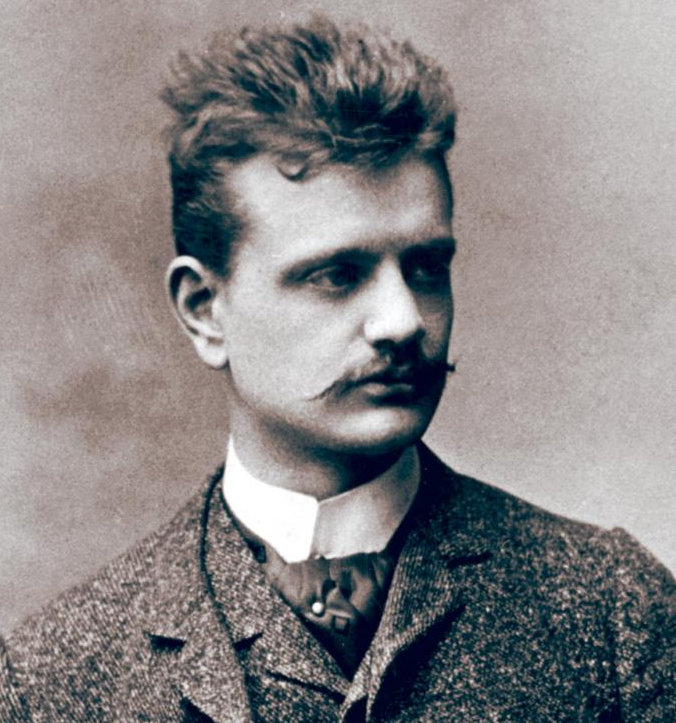|
||
|
Johan (Jean) Julius Christian Sibelius, was born on 8 December 1865 the Grand Duchy of Finland, at that time an autonomous part of the Russian Empire. Although his family had once been wealthy, his father died of typhus when Jean was thee years old leaving substantial debts. As a consequence his mother sold their home and the family moved into her mother's house where Jean grew up. He began piano lessons at the age of seven under the direction of his aunt Julia, who reputedly struck him on the knuckles whenever he played a wrong note. Fortunately his uncle, Pehr Ferdinand Sibelius, was more sympathetic in his approach to musical education. Uncle Pehr was an enthusiastic and talented musician and became like a father and musical mentor to the boy, giving him a violin and encouraging him to compose music. In his childhood his family name was "Janne" a diminutive of Johan. He retained this name throughout his life, and when a student he changed the spelling to Jean. Although his family spoke Swedish, he was educated at a Finnish-language lyceum where he was reportedly a rather absent-minded pupil. After an undistinguished school career he passed the examinations allowing him to enter the university. Initially he studied law, but after less than one year he moved to the Helsinki Music Institute, which has now been renamed the Sibelius Academy in his honour. He did compose some interesting works there, but his focus was on the violin, and his ambition was to become a virtuoso performer. However in his late twenties he finally abandoned that goal writing: "My tragedy was that I wanted to be a celebrated violinist at any price. Since the age of 15 I played my violin practically from morning to night. I hated pen and ink, and unfortunately I preferred an elegant violin bow. My love for the violin lasted quite long and it was a very painful awakening when I had to admit that I had begun my training for the exacting career of a virtuoso too late." Although he never became a virtuoso violinist he was later to write some of the greatest music in the violin repertoire. His fame as a composer began in his student days. It was the time when the Russian government had imposed sanctions on the Finnish language and culture. His music quickly became an insistent voice calling for Finnish independence, ironically so, since his early work displayed a distinct influence from Tchaikovsky. For twenty five years he produced a succession of masterpieces, including his first five symphonies, the violin concerto and many shorter orchestral or chamber music pieces, often based on Finnish legends, and incorporating Finnish folk music into highly evolved and original musical structures. After the Russian revolution in 1917 Finland was granted independence, and at this point his musical output began to decline. Between 1917 and 1926 he wrote only a few major works notably his sixth and seventh symphonies and the orchestral tone poem Tapiola. Then he fell silent until his death in 1957. He was offered a highly prestigious commission from the Royal Philharmonic Society of London to write an eighth symphony - the same society had commissioned Beethoven's Ninth and Dvorak's Seventh symphony. Although he told his friends and his sponsors that he was working on it, at his death not a note of it was found in his papers. He was always a self critical composer - a characteristic that in his youth contributed to his success, but in his old age became destructive. It is known that he burned many of his manuscripts, including the Karelia Music Tableau and the tone poem Tapiola. These works have only survived because copies had been made for the first performances. There is a speculation that at the same time the manuscript of much of the eighth symphony ended up as ashes in the grate of stove in his dining room. How much of the eighth symphony was actually written will never be known. The Karelia musical tableau was written in 1893 for the Viipuri Students' Association. It was premièred in the Imperial Alexander University in Helsinki. It is a set of musical pictures describing historical events, dating from 1293, in Karelia, a region which is now split between Finland and Russia. Significantly it ends with the Finnish national anthem. Sibelius conducted the first performance himself, in front of a rowdy but enthusiastic audience. In a letter to his brother he wrote: "You couldn't hear a single note of the music — everyone was on their feet cheering and clapping." In 1899 the overture, and the three movements that make up the Karelia Suite were published. The rest of the score was lost - burnt in old age by the composer - and the original movements only exist now in reconstructions from the surviving orchestral parts of the first performance. The suite is in the three movements. The first - with the rather inappropriate title "Intermezzo" - describes the people of Karelia rising up against oppression of the Lithuanians. It begins quietly with the horns sounding a rallying call, which is then taken up by the trumpets in an heroic style building to a forceful march before quickly fading into quiet uncertainty again. It is a very striking example of Sibelius' nationalistic style of composition. The second movement - "Ballade" - is based on a Karelain folk melody which is treated simply creating piece of lyrical beauty. The final movement "Alla Marcia" is a jaunty quick march echoing ideas of the first movement, but this time full of triumph, and finishing with a brilliant flourish on the piccolo. The Karelia suite was the first major triumph of Sibelius as a composer, and has been a regular concert favourite ever since its first performance. The Karelia Suite was performed by the Portobello Orchestra on the 21st November 2015, conducted by William Church. back |

